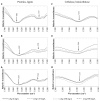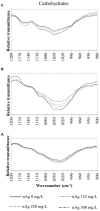Effects of Silver Nanoparticles on Radish Sprouts: Root Growth Reduction and Modifications in the Nutritional Value
- PMID: 26909084
- PMCID: PMC4754487
- DOI: 10.3389/fpls.2016.00090
Effects of Silver Nanoparticles on Radish Sprouts: Root Growth Reduction and Modifications in the Nutritional Value
Abstract
Reports indicate that silver nanoparticles (nAg) are toxic to vegetation, but little is known about their effects in crop plants. This study examines the impacts of nAg on the physiology and nutritional quality of radish (Raphanus sativus) sprouts. Seeds were germinated and grown for 5 days in nAg suspensions at 0, 125, 250, and 500 mg/L. Seed germination and seedling growth were evaluated with traditional methodologies; the uptake of Ag and nutrients was quantified by inductively coupled plasma-optical emission spectroscopy (ICP-OES) and changes in macromolecules were analyzed by infrared (IR) spectroscopy. None of the nAg concentrations reduced seed germination. However, the water content (% of the total weight) was reduced by 1.62, 1.65, and 2.54% with exposure to 125, 250, and 500 mg/L, respectively, compared with the control. At 500 mg/L, the root and shoot lengths were reduced by 47.7 and 40%, with respect to the control. The seedlings exposed to 500 mg/L had 901 ± 150 mg Ag/kg dry wt and significantly less Ca, Mg, B, Cu, Mn, and Zn, compared with the control. The infrared spectroscopy analysis showed changes in the bands corresponding to lipids (3000-2800 cm(-1)), proteins (1550-1530 cm(-1)), and structural components of plant cells such as lignin, pectin, and cellulose. These results suggest that nAg could significantly affect the growth, nutrient content and macromolecule conformation in radish sprouts, with unknown consequences for human health.
Keywords: FTIR; elemental analysis; macromolecules; radish; silver nanoparticles.
Figures





Similar articles
-
Co-exposure to titanium dioxide nanoparticles does not affect cadmium toxicity in radish seeds (Raphanus sativus).Ecotoxicol Environ Saf. 2018 Feb;148:359-366. doi: 10.1016/j.ecoenv.2017.10.051. Epub 2017 Nov 6. Ecotoxicol Environ Saf. 2018. PMID: 29096262
-
Citric acid modifies surface properties of commercial CeO2 nanoparticles reducing their toxicity and cerium uptake in radish (Raphanus sativus) seedlings.J Hazard Mater. 2013 Dec 15;263 Pt 2:677-84. doi: 10.1016/j.jhazmat.2013.10.030. Epub 2013 Oct 24. J Hazard Mater. 2013. PMID: 24231324
-
Deciphering physio-biochemical, yield, and nutritional quality attributes of water-stressed radish (Raphanus sativus L.) plants grown from Zn-Lys primed seeds.Chemosphere. 2018 Mar;195:175-189. doi: 10.1016/j.chemosphere.2017.12.059. Epub 2017 Dec 18. Chemosphere. 2018. PMID: 29268176
-
Toxic effects of antimony on the seed germination and seedlings accumulation in Raphanus sativus L. radish and Brassica napus L.Mol Biol Rep. 2018 Dec;45(6):2609-2614. doi: 10.1007/s11033-018-4430-2. Epub 2018 Oct 24. Mol Biol Rep. 2018. PMID: 30357585
-
Sprouts Use as Functional Foods. Optimization of Germination of Wheat (Triticum aestivum L.), Alfalfa (Medicago sativa L.), and Radish (Raphanus sativus L.) Seeds Based on Their Nutritional Content Evolution.Foods. 2022 May 18;11(10):1460. doi: 10.3390/foods11101460. Foods. 2022. PMID: 35627030 Free PMC article.
Cited by
-
Biostimulation and toxicity: The magnitude of the impact of nanomaterials in microorganisms and plants.J Adv Res. 2021 Jan 5;31:113-126. doi: 10.1016/j.jare.2020.12.011. eCollection 2021 Jul. J Adv Res. 2021. PMID: 34194836 Free PMC article. Review.
-
Assessment of Morpho-Physiological and Biochemical Responses of Mercury-Stressed Trigonella foenum-gracum L. to Silver Nanoparticles and Sphingobacterium ginsenosidiumtans Applications.Plants (Basel). 2021 Jul 1;10(7):1349. doi: 10.3390/plants10071349. Plants (Basel). 2021. PMID: 34371552 Free PMC article.
-
Growth-Stimulating Activity of Natural Polymer-Based Nanocomposites of Selenium during the Germination of Cultivated Plant Seeds.Dokl Biochem Biophys. 2020 Nov;495(1):296-299. doi: 10.1134/S1607672920060113. Epub 2020 Dec 25. Dokl Biochem Biophys. 2020. PMID: 33368038
-
Preparation, characterization of silver phyto nanoparticles and their impact on growth potential of Lupinus termis L. seedlings.Saudi J Biol Sci. 2018 Feb;25(2):313-319. doi: 10.1016/j.sjbs.2017.08.013. Epub 2017 Sep 1. Saudi J Biol Sci. 2018. PMID: 29472784 Free PMC article.
-
Toxicity Assessment of Biogenic Gold Nanoparticles on Crop Seeds and Zebrafish Embryos: Implications for Agricultural and Aquatic Ecosystems.ACS Omega. 2025 Jan 3;10(1):1032-1046. doi: 10.1021/acsomega.4c08287. eCollection 2025 Jan 14. ACS Omega. 2025. PMID: 39829554 Free PMC article.
References
-
- Baenas N., Ferreres F., García-Viguera C., Moreno D. A. (2015). Radish sprouts—characterization and elicitation of novel varieties rich in anthocyanins. Food Res. Int. 69 305–312. 10.1016/j.foodres.2015.01.009 - DOI
-
- Cabane M., Afif D., Hawkins S. (2012). “Chapter 7: Lignins and abiotic stresses,” in Advances in Botanical Research, eds Lise J., Catherine L. (Cambridge, MA: Academic Press; ), 219–262.
-
- Chang Y.-N., Zhang M., Xia L., Zhang J., Xing G. (2012). The toxic effects and mechanisms of CuO and ZnO nanoparticles. Materials 5 2850–2871. 10.3390/ma5122850 - DOI
Grants and funding
LinkOut - more resources
Full Text Sources
Other Literature Sources

